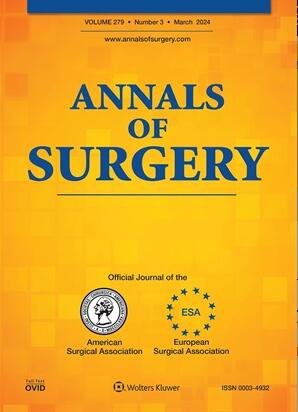The Rise of Robot-Assisted Surgery in the Netherlands: An Overview of its Adoption over the Last Decade.
IF 6.4
1区 医学
Q1 SURGERY
引用次数: 0
Abstract
To assess nationwide trends in the use of robot-assisted surgery (RAS) for high-complex, low-volume resections in the Netherlands. RAS is growing globally, offering substantial value in high-complex, low-volume gastrointestinal and thoracic surgery. However, nationwide data on its adoption are lacking. The Netherlands maintains mandatory clinical audits for major oncologic surgeries, offering a unique opportunity to evaluate RAS adoption. All patients undergoing pancreatic, colorectal, liver, thoracic, and esophagogastric cancer surgery registered in national audits in the Netherlands were included (audit start-2023). Primary endpoint was annual RAS rate. Secondary endpoints included number of centers performing RAS and trends in patient, tumor and treatment characteristics of RAS patients. In total, 77,361 resections were included: 10,336 pancreatic, 29,821 thoracic, 30,256 colorectal, 4,762 liver and 2,186 esophagogastric. Nationwide RAS use increased from 1% to 33% in pancreatic (2014-2023), 3% to 11% in thoracic (2016-2023), 6% to 14% in colon, 19% to 45% in rectal (2018-2023), 10% to 25% in liver (2020-2023), and 33% to 40% in esophageal, and remained 19% in gastric surgery (2022-2023). By 2023, RAS was used in 20% of all procedures, with 15/16 (94%) pancreatic centers performing RAS, compared to 12/42 (29%) in thoracic surgery. RAS was adopted mostly in left pancreatectomy (50%), total mesorectal excisions (48%) and mediastinal tumor resections (46%). RAS expanded across multiple patient and tumor types within all disciplines. This study confirms a steep nationwide rise in RAS use for rectal, pancreatic, esophageal, liver, gastric, colon and thoracic surgery, with greater adoption in certain procedures and overseen by national audits.机器人辅助手术在荷兰的兴起:过去十年的采用概况。
评估机器人辅助手术(RAS)在荷兰用于高复杂性、小体积切除的全国趋势。RAS在全球范围内不断发展,在高复杂性、低容量的胃肠和胸外科手术中提供了巨大的价值。然而,缺乏全国范围内的采用数据。荷兰对大型肿瘤手术实行强制性临床审计,为评估RAS的采用提供了一个独特的机会。所有在荷兰国家审计中登记的接受胰腺癌、结直肠癌、肝癌、胸癌和食管胃癌手术的患者被纳入(审计开始于2023年)。主要终点为年RAS率。次要终点包括实施RAS的中心数量以及RAS患者的趋势、肿瘤和治疗特征。总共包括77,361例切除术:胰腺10,336例,胸部29,821例,结肠30,256例,肝脏4,762例,食管胃2,186例。全国范围内,RAS在胰腺手术中的使用率从1%增加到33%(2014-2023年),在胸腔手术中从3%增加到11%(2016-2023年),在结肠手术中从6%增加到14%,在直肠手术中从19%增加到45%(2018-2023年),在肝脏手术中从10%增加到25%(2020-2023年),在食管手术中从33%增加到40%,在胃手术中保持19%(2022-2023年)。到2023年,20%的手术使用RAS, 15/16(94%)的胰腺中心使用RAS,而12/42(29%)的胸外科手术使用RAS。RAS主要用于左胰切除术(50%)、全肠系膜切除术(48%)和纵隔肿瘤切除术(46%)。RAS扩展到所有学科的多种患者和肿瘤类型。这项研究证实,在直肠、胰腺、食管、肝脏、胃、结肠和胸外科手术中,RAS的使用在全国范围内急剧上升,在某些手术中采用得更多,并受到国家审计的监督。
本文章由计算机程序翻译,如有差异,请以英文原文为准。
求助全文
约1分钟内获得全文
求助全文
来源期刊

Annals of surgery
医学-外科
CiteScore
14.40
自引率
4.40%
发文量
687
审稿时长
4 months
期刊介绍:
The Annals of Surgery is a renowned surgery journal, recognized globally for its extensive scholarly references. It serves as a valuable resource for the international medical community by disseminating knowledge regarding important developments in surgical science and practice. Surgeons regularly turn to the Annals of Surgery to stay updated on innovative practices and techniques. The journal also offers special editorial features such as "Advances in Surgical Technique," offering timely coverage of ongoing clinical issues. Additionally, the journal publishes monthly review articles that address the latest concerns in surgical practice.
 求助内容:
求助内容: 应助结果提醒方式:
应助结果提醒方式:


